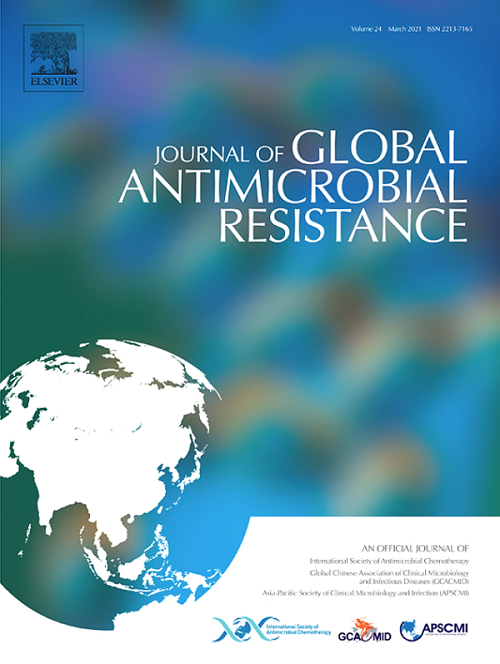Characterization of the tet(M)-bearing transposon Tn7125 of Escherichia coli strain A13 isolated from an intensive pig farm located in Henan province, China
IF 3.2
3区 医学
Q2 INFECTIOUS DISEASES
引用次数: 0
Abstract
Background
Transposons carrying tet(M) in Gram-positive bacteria have been reported extensively, while there is a paucity of data on the transmission characteristics of tet(M) in Gram-negative bacteria. Therefore, the aim of this study was to investigate the genetic characteristics of the tet(M)-bearing transposon Tn7125, and to clarify the transmission mechanism of the plasmids pTA13-1 and pTA13-3 in Escherichia coli strain A13.
Methods
Plasmids from strain A13 and a corresponding transconjugant were determined by whole genome sequencing and analyzed using bioinformatics tools. The plasmids pTA13-1 and pTA13-3 of the transconjugant TA13 were characterized by S1-pulse-field gel electrophoresis, Southern hybridization, stability experiments, and direct competition assays.
Results
The conjugated IncF2:A6:B20 plasmid pTA13-1 co-transferred with the 41-kb plasmid pTA13-3, which carried no resistance genes; plasmid pTA13-2, which harbored the replication initiator PO111; and the IncX4 plasmid pTA13-4, which harbored the antibiotic resistance gene mcr-1. The novel IS26-bracked composite transposon Tn7125 was located on plasmid pTA13-1, which mainly consists of three resistance modules: IS26-ctp-lp-tet(M)-hp-IS406tnp, qac-aadA1-cmlA1-aadA2-DUF1010-dfrA12, and ∆ISVSa3-VirD-floR-LysR-ISVSa3. The plasmid pTA13-1 was highly stable in E. coli strain J53 with no fitness cost to the host or disadvantage in growth competition.
Conclusion
Evolution of co-integrated transposons, such as Tn7125, may convey antibiotic resistance to a wide spectrum of hosts via the plasmids pTA13-1 and pTA13-3, which acts as an adaptable and mobile multidrug resistance reservoir to accelerate dissemination of other genes by co-selection, thereby posing a potentially serious barrier to clinical treatment regimens.
河南省某集约化养猪场A13大肠埃希菌携带tet(M)转座子Tn7125的鉴定
背景:革兰氏阳性菌中携带tet(M)的转座子已被广泛报道,而革兰氏阴性菌中tet(M)的传播特征缺乏数据。因此,本研究的目的是研究携带tet(M)转座子Tn7125的遗传特性,并阐明质粒pTA13-1和pTA13-3在大肠杆菌A13中的传播机制。方法:采用全基因组测序方法对菌株A13的质粒及相应的转偶联物进行鉴定,并利用生物信息学工具进行分析。质粒pTA13-1和pTA13-3通过s1脉冲场凝胶电泳、Southern杂交、稳定性实验和直接竞争分析进行了鉴定。结果:结合的IncF2:A6:B20质粒pTA13-1与41kb质粒pTA13-3共转移,不携带抗性基因;质粒pTA13-2,内含复制起始物PO111;以及含有抗生素耐药基因mcr-1的IncX4质粒pTA13-4。新型is26支架复合转座子Tn7125位于质粒pTA13-1上,主要由三个抗性模块组成:IS26-ctp-lp-tet(M)-hp-IS406tnp、qac-aadA1-cmlA1-aadA2-DUF1010-dfrA12、∆ISVSa3-VirD-floR-LysR-ISVSa3。质粒pTA13-1在大肠杆菌菌株J53中具有很高的稳定性,对宿主没有适应性成本,在生长竞争中也没有劣势。结论:Tn7125等共整合转座子的进化可能通过pTA13-1和pTA13-3质粒将抗生素耐药性传递给广泛的宿主,pTA13-1和pTA13-3质粒作为适应性和可移动的多药耐药库,通过共选择加速其他基因的传播,从而对临床治疗方案构成潜在的严重障碍。
本文章由计算机程序翻译,如有差异,请以英文原文为准。
求助全文
约1分钟内获得全文
求助全文
来源期刊

Journal of global antimicrobial resistance
INFECTIOUS DISEASES-PHARMACOLOGY & PHARMACY
CiteScore
8.70
自引率
2.20%
发文量
285
审稿时长
34 weeks
期刊介绍:
The Journal of Global Antimicrobial Resistance (JGAR) is a quarterly online journal run by an international Editorial Board that focuses on the global spread of antibiotic-resistant microbes.
JGAR is a dedicated journal for all professionals working in research, health care, the environment and animal infection control, aiming to track the resistance threat worldwide and provides a single voice devoted to antimicrobial resistance (AMR).
Featuring peer-reviewed and up to date research articles, reviews, short notes and hot topics JGAR covers the key topics related to antibacterial, antiviral, antifungal and antiparasitic resistance.
 求助内容:
求助内容: 应助结果提醒方式:
应助结果提醒方式:


